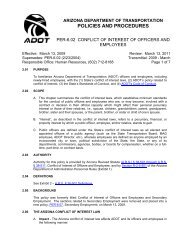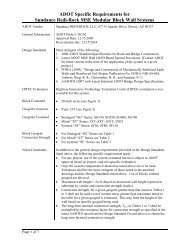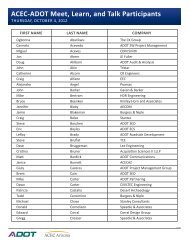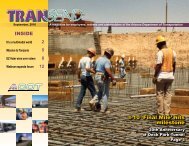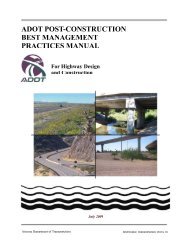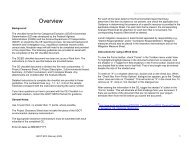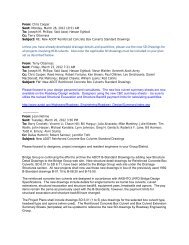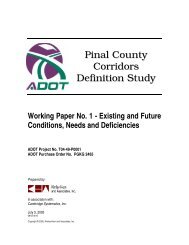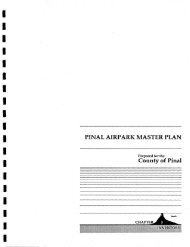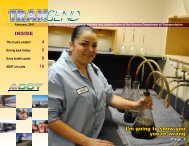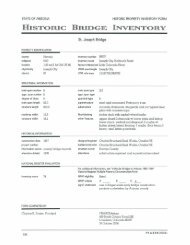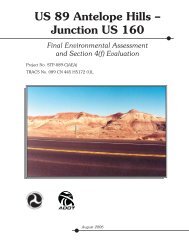I-10 Twin Peaks Traffic Interchange, Environmental Assessment
I-10 Twin Peaks Traffic Interchange, Environmental Assessment
I-10 Twin Peaks Traffic Interchange, Environmental Assessment
Create successful ePaper yourself
Turn your PDF publications into a flip-book with our unique Google optimized e-Paper software.
Affected Environment and <strong>Environmental</strong> Impacts October 2005<br />
Mitigation<br />
To comply with Section 402, a SWPPP would be prepared for this project by the<br />
Town of Marana. The SWPPP would incorporate temporary erosion control<br />
measures during construction, permanent erosion control measures when the<br />
project is completed, and good housekeeping practices for the control and<br />
prevention of release of water pollutants. The SWPPP would identify the project<br />
scope, anticipated acreage of land disturbance, and the pollution control measures<br />
that would be implemented to reduce soil erosion, while containing and<br />
minimizing the construction pollutants (including oils, gasoline, and other<br />
chemicals released by construction equipment and vehicles) that may be released<br />
to surface waters through runoff during a storm event. The ADOT District<br />
Construction Office and the contractor will submit the Notice of Intent and the<br />
Notice of Termination to the Arizona Department of <strong>Environmental</strong> Quality and<br />
the EPA. ADOT would monitor all mitigation measures encompassing<br />
sedimentation and erosion control measures to affirm that these measures are being<br />
followed correctly and are providing the appropriate protection to sensitive areas.<br />
During construction of the project, care shall be taken to ensure that construction<br />
materials are not introduced into the washes, in accordance with Arizona<br />
Department of Transportation’s Standard Specifications for Road and Bridge<br />
Construction Section <strong>10</strong>4.09 (2000 Edition) and the Water Quality Standards in<br />
Title 18, Chapter 11 of the Arizona Administrative Code as administered by<br />
ADEQ. Excess concrete, curing agents, form work, waste materials, lubricants,<br />
and fuel would not be disposed of within the project boundaries. In the event of<br />
accidental chemical spills during construction, the site would be cleaned up to<br />
prevent chemical introduction into the surface or groundwater systems. Incidents<br />
involving hazardous materials would be coordinated by ADOT's Engineer. These<br />
measures would protect both surface and groundwater.<br />
Sole Source Aquifer<br />
Existing Conditions<br />
Under Section 1424(e) of the Safe Drinking Water Act, the U.S. <strong>Environmental</strong><br />
Protection Agency (EPA) designated the Upper Santa Cruz and Avra Valley<br />
Basin, which underlies the study area, as a sole source aquifer. This designation<br />
means that the area has an aquifer which is the sole or principal drinking water<br />
source for the area and which, if contaminated, would create a significant hazard to<br />
public health.<br />
As a result of this designation, proposed federal financially-assisted projects which<br />
have the potential to contaminate the designated sole source aquifer are subject to<br />
EPA review. Under a Memorandum of Understanding between EPA and FHWA<br />
dated October 1984, any proposed project that is within a designated sole source<br />
aquifer and which is subject to analysis through an environmental assessment, is<br />
subject to a Section 1424(e) review by EPA.<br />
Interstate <strong>10</strong> <strong>Traffic</strong> <strong>Interchange</strong> at<br />
<strong>Twin</strong> <strong>Peaks</strong>/Linda Vista<br />
4-22<br />
Project No.: NH-0<strong>10</strong>-D (AIW)<br />
TRACS No.: <strong>10</strong> PM 236 H5838 01D



